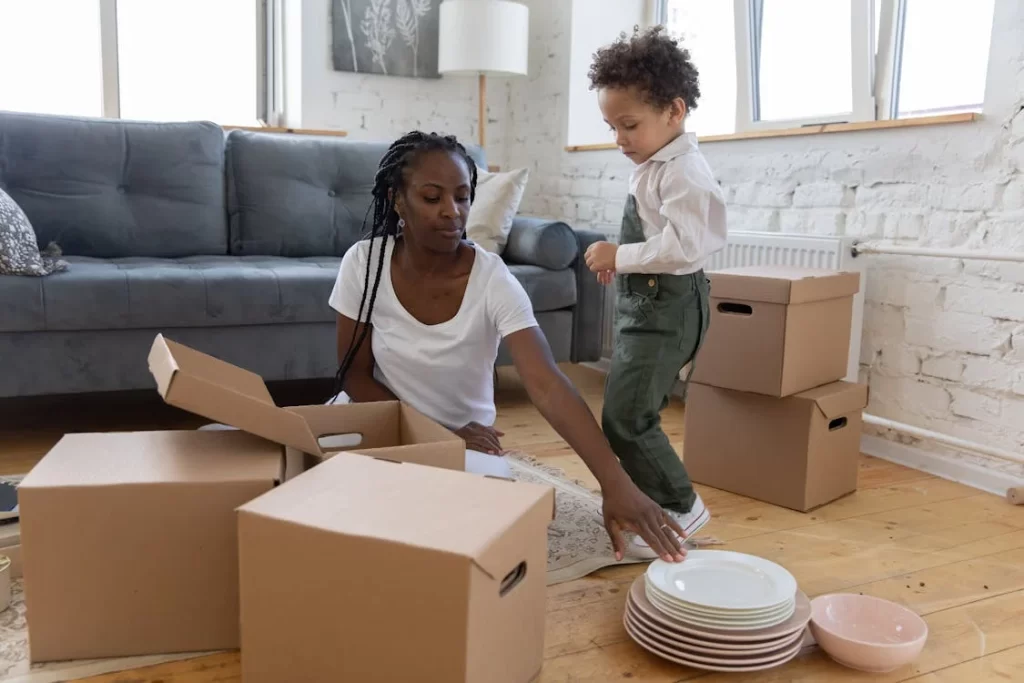Table of Contents
Moving on a tight timeline can be overwhelming, but with the right strategies and a well-organized plan, it is entirely manageable. If you find yourself needing to move in less than 30 days, this comprehensive guide is here to help you navigate the process smoothly. From quick move planning to implementing emergency moving plans, we’ve got you covered with detailed, step-by-step instructions.
Understanding the Urgency: Why Do You Need to Move Quickly?
Common Reasons for a Quick Move
Job Relocation: Sometimes, job opportunities come with immediate start dates, requiring a fast move. Relocating for work can be both exciting and stressful, especially when the new position demands your presence sooner than expected.
Lease Termination: Unforeseen circumstances, such as lease termination or eviction, can force a rapid relocation. Legal issues, disputes with landlords, or changes in property ownership can suddenly leave you looking for a new place.
Family Emergencies: Health issues or family crises often necessitate quick relocations. Caring for an ill relative or moving to provide support during a difficult time can require immediate action.
Natural Disasters: Events like floods, hurricanes, or wildfires can prompt emergency moves. When safety is at risk, evacuating and relocating become urgent priorities.
Understanding the urgency behind your move can help you prioritize tasks and stay focused on your goal. Knowing why you’re moving will also help you communicate your needs to movers, friends, and family who might be assisting you.

Step-by-Step Guide to Quick Move Planning
1. Assess Your Situation and Create a Plan
Take Inventory
Start by taking a quick inventory of your belongings. Categorize items into essentials, non-essentials, and items to donate or discard. This step will help you determine the volume of items you need to move and streamline the packing process. An inventory also helps prevent losing track of important items.
Set a Timeline
With only 30 days or less, every day counts. Create a detailed timeline outlining what needs to be done each day. This will help you stay on track and ensure nothing is overlooked. Break down tasks into manageable daily goals, and make sure to build in some buffer time for unexpected delays.
Establish a Budget
Moving can be costly, especially on short notice. Establish a budget that includes all potential expenses such as packing supplies, moving services, transportation, and unexpected costs. Account for every possible expense, from utility deposits at your new place to meals on the go during your move.
2. Declutter Ruthlessly
Why Decluttering is Crucial
Decluttering not only reduces the volume of items to move but also makes packing more manageable. It’s an opportunity to get rid of things you no longer need or use. A leaner move is quicker and easier, saving time and money.
How to Declutter Effectively
Sort and Purge: Go through each room and decide what to keep, donate, or discard. Aim to touch each item only once and make quick decisions to maintain momentum.
Donate or Sell Items: Consider donating items to charity or selling them online or through a garage sale. Apps and websites can facilitate quick sales, turning unwanted items into extra cash.
Dispose of Unwanted Items: Safely dispose of items that cannot be donated or sold. Check for local disposal guidelines to handle hazardous materials correctly.
3. Gather Packing Supplies
Essential Packing Materials
Boxes: Various sizes for different items. Ensure you have a mix of small, medium, and large boxes to accommodate different belongings.
Packing Tape: Strong tape to secure boxes. Consider using a tape dispenser to speed up the process.
Bubble Wrap and Packing Paper: For protecting fragile items. These materials prevent breakage and ensure your valuables arrive intact.
Markers and Labels: For labeling boxes. Clear labels help with organization and make unpacking easier.
Furniture Covers: To protect furniture during transit. These prevent scratches and damage, keeping your items in good condition.
Where to Find Packing Supplies
Purchase Online: Many retailers offer packing supplies online, often with quick delivery options.
Local Stores: Home improvement stores and office supply stores often carry moving supplies. These can be convenient for last-minute purchases.
Ask Around: Friends or neighbors who have recently moved may have leftover supplies. Recycling boxes and materials can save money and reduce waste.
4. Start Packing Immediately
Packing Strategies for Efficiency
Room-by-Room Approach: Focus on one room at a time to stay organized. This method helps maintain order and prevents feeling overwhelmed.
Label Everything: Clearly label each box with its contents and the room it belongs to. Include a brief inventory of key items in each box for easy reference.
Pack Essentials Separately: Keep a separate box for essential items you’ll need immediately upon arrival. This “first-night” box should include toiletries, basic kitchen items, and a few changes of clothes.
Tips for Packing Different Items
Fragile Items: Use plenty of cushioning materials and clearly mark these boxes as “fragile.”
Clothing: Pack clothes in wardrobe boxes or use suitcases. Vacuum-sealed bags can save space.
Books and Documents: Pack in small boxes to prevent them from becoming too heavy.
Electronics: Use original packaging if available, or ensure they are well-padded and secure.
5. Hire Professional Movers or Rent a Truck
Pros and Cons of Hiring Movers vs. DIY Moving
Hiring Movers: Professional movers can save you time and stress but may be more expensive. They provide expertise and efficiency, especially for complex moves.
DIY Moving: Renting a truck and moving yourself can be cost-effective but requires more effort and planning. You’ll need to coordinate every aspect, from loading to driving and unloading.
How to Choose a Moving Company
Research: Look for reputable movers with good reviews. Check for credentials, licenses, and insurance coverage.
Get Quotes: Request quotes from multiple companies to compare prices. Be sure to understand what each quote includes.
Check Availability: Ensure the company can accommodate your timeline. Short notice may limit your options, so start this process early.
6. Notify Important Parties
Who to Notify
Utilities: Arrange for the disconnection and reconnection of utilities such as electricity, water, gas, and internet.
Postal Service: Change your address with the postal service to forward mail. This can usually be done online for convenience.
Banks and Credit Cards: Update your address with financial institutions to avoid any disruptions in service.
Subscriptions: Update your address for magazine subscriptions and other services. Ensure you don’t miss important deliveries or publications.
Additional Notifications
Healthcare Providers: Notify your doctors and obtain copies of your medical records.
Schools: Inform your children’s schools about the move and arrange for the transfer of records.
Insurance Companies: Update your address for health, home, and auto insurance.
7. Handle Administrative Tasks
Change of Address
Notify the Post Office: Submit a change of address form online or in person. This ensures your mail is forwarded to your new address.
Update Your Address: Notify banks, insurance companies, and other important entities. This step helps prevent missed bills and important communications.
Transfer or Cancel Services
Utilities: Schedule the disconnection and reconnection of utilities at your new address. This includes electricity, water, gas, and internet services.
Subscriptions: Cancel or transfer subscriptions and memberships. This ensures you continue to receive services without interruption.
Legal and Financial Considerations
Lease Agreements: Review your lease agreements to understand any requirements for moving out.
Deposit Refunds: Arrange for the return of security deposits and address any outstanding balances.

Tips for Moving Day
Preparing for Moving Day
Confirm Details with Movers: Double-check the moving date, time, and any special instructions with your movers. Confirm the arrival time and any specific requirements.
Pack a Moving Day Essentials Kit: Include items like toiletries, medications, a change of clothes, and important documents. This kit should be easily accessible throughout the move.
Prepare Your Home: Make sure everything is packed and ready to go. Disconnect appliances and take apart furniture if necessary. Ensure pathways are clear for easy movement of items.
During the Move
Supervise the Process: Be present to oversee the loading and unloading of your belongings. Provide guidance to movers and ensure fragile items are handled with care.
Conduct a Final Walkthrough: Check each room to ensure nothing is left behind. Look in closets, cabinets, and behind doors.
After the Move
Unpack Essentials First: Start with the essentials kit to make your first night comfortable. Gradually unpack other items based on priority.
Inspect Your Items: Check for any damages and report them to the moving company if needed. Document any issues with photos.
Settle In: Take your time to unpack and arrange your new home. Focus on creating a comfortable and functional space.
Fast Relocation Strategies for Success
Stay Organized
Keep all important documents, receipts, and contact information in one place. Use checklists to stay on top of tasks. Consider using a moving app to help manage your tasks and timelines.
Stay Flexible
Be prepared for unexpected challenges and have a backup plan in case things don’t go as planned. Flexibility can help reduce stress and keep the process moving forward.
Stay Calm
Moving can be stressful, but staying calm and focused will help you handle the process more effectively. Take breaks when needed and maintain a positive attitude.
Time Management Tips
Prioritize Tasks: Focus on high-priority tasks first and tackle smaller tasks during downtime.
Delegate: Don’t be afraid to ask for help from friends and family. Assign specific tasks to trusted individuals.
Break Tasks into Steps: Large tasks can be overwhelming. Breaking them down into smaller, manageable steps makes them more approachable.

Emergency Moving Plans: When Time is of the Essence
How to Handle Unexpected Moves
Prioritize Tasks: Focus on the most critical tasks first. Identify what must be done immediately and what can wait.
Seek Help: Don’t hesitate to ask friends or family for assistance. Extra hands can make the process quicker and less stressful.
Use Professional Services: Consider hiring a professional moving company to expedite the process. Professionals can handle the heavy lifting and logistics.
Tips for Minimizing Stress
Stay Positive: Keep a positive attitude and focus on the end goal. Remember why you’re moving and the benefits it will bring.
Take Breaks: Give yourself time to rest and recharge. Short breaks can improve focus and productivity.
Stay Healthy: Eat well, stay hydrated, and get enough sleep. Taking care of your physical health helps manage stress and maintain energy levels.
Additional Tips and Strategies
Additional Packing Tips
Packing Fragile Items
Use Plenty of Padding: Ensure fragile items are surrounded by bubble wrap, packing paper, or foam peanuts.
Double Box for Extra Protection: Place fragile items in a smaller box, then place that box in a larger one with additional padding in between.
Label Clearly: Mark boxes containing fragile items clearly and ensure movers are aware of their contents.
Packing Electronics
Back Up Data: Before packing computers and other electronics, back up important data to an external drive or cloud storage.
Use Original Packaging: If possible, pack electronics in their original boxes with original padding.
Remove Batteries: Take out batteries from devices to prevent leakage during the move.
Packing Furniture
Disassemble When Possible: Take apart large furniture pieces to make them easier to move and reduce the risk of damage.
Use Furniture Pads: Protect furniture with pads or blankets to prevent scratches and dents.
Secure Loose Parts: Place screws, bolts, and other small parts in labeled bags and tape them to the corresponding furniture pieces.
Moving with Pets
Plan for Pet Care: Arrange for pet care on moving day to keep them safe and out of the way.
Pack a Pet Essentials Kit: Include food, water, bowls, bedding, and any medications your pet may need.
Update Pet Identification: Ensure your pet’s tags and microchip information are updated with your new address.
Moving with Children
Involve Them in the Process: Allow children to help with age-appropriate tasks to make them feel included.
Pack a Comfort Bag: Include favorite toys, snacks, and activities to keep them occupied during the move.
Arrange for Childcare: If possible, arrange for childcare on moving day to keep them safe and entertained.
Final Preparations Before Moving
Defrost the Freezer: If you’re taking your refrigerator with you, defrost it at least 24 hours before moving.
Dispose of Hazardous Materials: Properly dispose of items like paint, propane, and chemicals that cannot be moved.
Confirm Moving Arrangements: Double-check all moving details, including the date, time, and contact information for your movers.
Settling into Your New Home
Clean Before Unpacking: Take the opportunity to clean your new home before unpacking. It’s easier to clean empty rooms.
Set Up Essentials First: Focus on setting up the kitchen, bedrooms, and bathrooms first to make the space functional quickly.
Explore Your New Neighborhood: Take some time to explore your new area, locate nearby stores, schools, and healthcare facilities.

Conclusion
A tight moving timeline can be daunting, but with these emergency moving plans and detailed tips, you can successfully navigate the process. Stay organized, enlist help when needed, and remain flexible to manage your move efficiently.
For expert assistance and a stress-free experience, contact Top Sacramento Moving Company. We specialize in quick and efficient moves, ensuring your relocation is smooth and seamless.
Why Choose Top Sacramento Moving Company?
Are you feeling overwhelmed by the prospect of a last-minute move? Let Top Sacramento Moving Company take the stress out of your hands. Our team of experienced professionals is equipped to handle moves of any size and urgency. We understand the challenges of moving on a tight timeline and are committed to providing efficient, reliable, and friendly service to make your move as smooth as possible.
At Top Sacramento Moving Company, we offer:
- Expert Movers: Our skilled team is trained to handle your belongings with care, ensuring everything arrives safely at your new home.
- Flexible Scheduling: We accommodate last-minute moves and work around your schedule to make the process convenient for you.
- Comprehensive Services: From packing and loading to transportation and unpacking, we provide a full range of moving services to meet your needs.
- Transparent Pricing: We offer competitive rates with no hidden fees, giving you peace of mind and helping you stay within your budget.
- Personalized Moving Plans: We tailor our services to your specific requirements, ensuring a customized moving experience that suits your timeline and preferences.
Contact us today for a free quote and discover how we can make your move smooth and efficient. Let Top Sacramento Moving Company turn your stressful moving situation into a seamless transition to your new home. Embrace the excitement of your new journey and leave the heavy lifting to us. Your satisfaction is our priority, and we are here to support you every step of the way.
